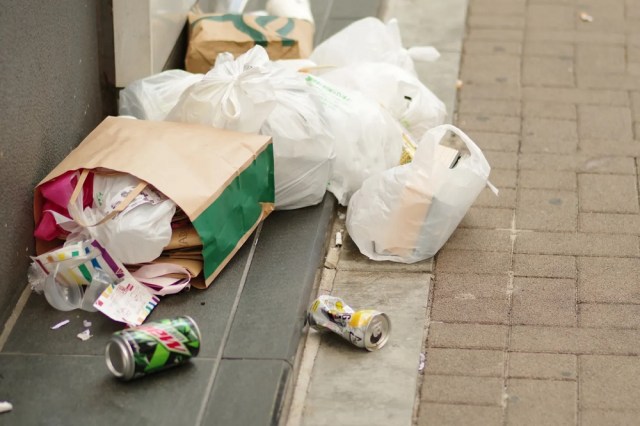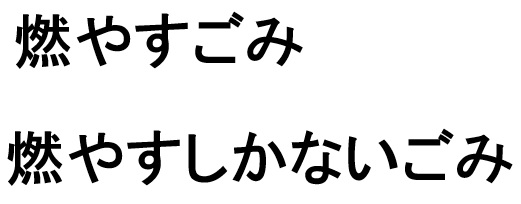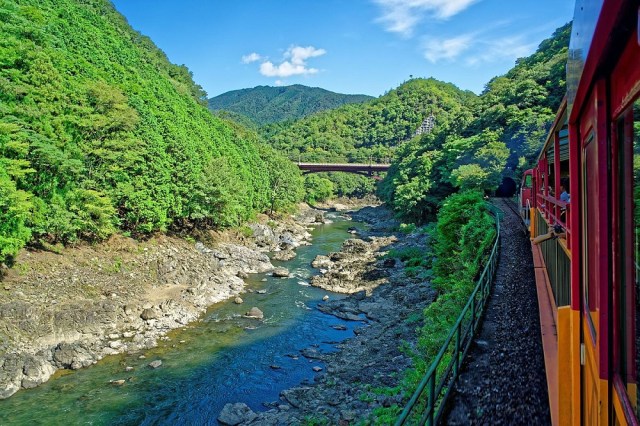
As always, words have a second meaning behind them in Kyoto.
Kyoto has a reputation as a place where there’s a second meaning behind people’s choice of words. Often that meaning is meant to subtly nudge the recipient’s behavior in a certain direction, like we’ve seen with “You have so many friends” or “You have such a nice watch.”
And now Kyoto Prefecture’s Kameoka City is doing a little rephrasing that it hopes will make residents rethink their actions. Starting April 1, the city will no longer refer to trash that’s going into the incinerator as “trash to be burned,” but as “trash for which the only option is to burn it.”
▼ They roll off the tongue a little easier in Japanese, as moyasu gomi (top) and moyasu shika nai gomi (bottom)
In addition, general non-burnable trash that goes into landfills, currently called “trash to be buried” (umetate gomi) will be renamed “trash for which the only option is to bury it” (umetateru shika nai gomi).
So why the changes? The logic is that the weightier-sounding finality of the new names will prompt people to think if burning or burying are really the only options for a particular piece of trash, which naturally means thinking about if it can be recycled instead. April 1 will also see a revision of Kameoka’s recycling ordinances, with new categories and pickup dates for categories such as paper, plants and wood, and small metal objects, which will bring the city’s total number of trash types up too 18. Even now, the city’s waste disposal department often finds items that should have been put out on pickup days for recyclables tossed in with trash to be burned, so the time seems right for a reminder that the real classification isn’t supposed to be anything that can be burned or dumped in a landfill, but rather those things that can’t be recycled.
▼ Kameoka is about a half-hour away from downtown Kyoto City and has a population of 85,000, but also boats beautiful natural scenery like this.
Kameoka isn’t the first city in Japan to make such a change for the name of its to-be-burned trash, but this is the first time we’ve heard of the strategy being used for landfill trash too. If the results are good, we might see more cities across Japan switching up their semantics for the good of the environment.
Source: Kyoto Shimbun via Hachima Kiko
Top image: Pakutaso
Insert images: SoraNews24, Wikipedia/Adeletron 3030
● Want to hear about SoraNews24’s latest articles as soon as they’re published? Follow us on Facebook and Twitter!



 Japanese city changes “burnable trash” bags to “the only option is to burn this trash” bags
Japanese city changes “burnable trash” bags to “the only option is to burn this trash” bags Titan trash can to be placed near a Coca-Cola vending machine in Oita to help promote recycling
Titan trash can to be placed near a Coca-Cola vending machine in Oita to help promote recycling Japanese Network TV asks Twitter user’s permission for “photo” of a trash home…from Fallout 76
Japanese Network TV asks Twitter user’s permission for “photo” of a trash home…from Fallout 76 “Recycling in Japan” or “Reasons to get it right and avoid eternal shame”
“Recycling in Japan” or “Reasons to get it right and avoid eternal shame” Japanese otaku now have special trash box just for merch of their former anime and idol crushes
Japanese otaku now have special trash box just for merch of their former anime and idol crushes McDonald’s new Happy Meals offer up cute and practical Sanrio lifestyle goods
McDonald’s new Happy Meals offer up cute and practical Sanrio lifestyle goods All-you-can-drink Starbucks and amazing views part of Tokyo’s new 170 meter-high sky lounge
All-you-can-drink Starbucks and amazing views part of Tokyo’s new 170 meter-high sky lounge More foreign tourists than ever before in history visited Japan last month
More foreign tourists than ever before in history visited Japan last month Starbucks reopens at Shibuya Scramble Crossing with new look and design concept
Starbucks reopens at Shibuya Scramble Crossing with new look and design concept Mister Donut ready to make hojicha dreams come true in latest collab with Kyoto tea merchant
Mister Donut ready to make hojicha dreams come true in latest collab with Kyoto tea merchant Beautiful Sailor Moon manhole cover coasters being given out for free by Tokyo tourist center
Beautiful Sailor Moon manhole cover coasters being given out for free by Tokyo tourist center The oldest tunnel in Japan is believed to be haunted, and strange things happen when we go there
The oldest tunnel in Japan is believed to be haunted, and strange things happen when we go there Disney princesses get official manga makeovers for Manga Princess Cafe opening in Tokyo
Disney princesses get official manga makeovers for Manga Princess Cafe opening in Tokyo We get our paws on all 50 Hello Kitty Happy Meal toys at McDonald’s Japan!
We get our paws on all 50 Hello Kitty Happy Meal toys at McDonald’s Japan! Japanese vending machines now sell pearl jewellery
Japanese vending machines now sell pearl jewellery We try out “Chan Ramen”, an underground type of ramen popular in the ramen community
We try out “Chan Ramen”, an underground type of ramen popular in the ramen community Beautiful new Final Fantasy T-shirt collection on the way from Uniqlo【Photos】
Beautiful new Final Fantasy T-shirt collection on the way from Uniqlo【Photos】 Foreign English teachers in Japan pick their favorite Japanese-language phrases【Survey】
Foreign English teachers in Japan pick their favorite Japanese-language phrases【Survey】 Is the new Shinkansen Train Desk ticket worth it?
Is the new Shinkansen Train Desk ticket worth it? There’s a park inside Japan where you can also see Japan inside the park
There’s a park inside Japan where you can also see Japan inside the park Japanese convenience store packs a whole bento into an onigiri rice ball
Japanese convenience store packs a whole bento into an onigiri rice ball Studio Ghibli releases Kiki’s Delivery Service chocolate cake pouches in Japan
Studio Ghibli releases Kiki’s Delivery Service chocolate cake pouches in Japan Japan’s bone-breaking and record-breaking roller coaster is permanently shutting down
Japan’s bone-breaking and record-breaking roller coaster is permanently shutting down New definition of “Japanese whiskey” goes into effect to prevent fakes from fooling overseas buyers
New definition of “Japanese whiskey” goes into effect to prevent fakes from fooling overseas buyers Foreign passenger shoves conductor on one of the last full runs for Japan’s Thunderbird train
Foreign passenger shoves conductor on one of the last full runs for Japan’s Thunderbird train Our Japanese reporter visits Costco in the U.S., finds super American and very Japanese things
Our Japanese reporter visits Costco in the U.S., finds super American and very Japanese things Kyoto bans tourists from geisha alleys in Gion, with fines for those who don’t follow rules
Kyoto bans tourists from geisha alleys in Gion, with fines for those who don’t follow rules Studio Ghibli unveils Mother’s Day gift set that captures the love in My Neighbour Totoro
Studio Ghibli unveils Mother’s Day gift set that captures the love in My Neighbour Totoro Domino’s Japan now sells…pizza ears?
Domino’s Japan now sells…pizza ears? New Japanese KitKat flavour stars Sanrio characters, including Hello Kitty
New Japanese KitKat flavour stars Sanrio characters, including Hello Kitty Sales of Japan’s most convenient train ticket/shopping payment cards suspended indefinitely
Sales of Japan’s most convenient train ticket/shopping payment cards suspended indefinitely Sold-out Studio Ghibli desktop humidifiers are back so Totoro can help you through the dry season
Sold-out Studio Ghibli desktop humidifiers are back so Totoro can help you through the dry season Japanese government to make first change to romanization spelling rules since the 1950s
Japanese government to make first change to romanization spelling rules since the 1950s Ghibli founders Toshio Suzuki and Hayao Miyazaki contribute to Japanese whisky Totoro label design
Ghibli founders Toshio Suzuki and Hayao Miyazaki contribute to Japanese whisky Totoro label design Doraemon found buried at sea as scene from 1993 anime becomes real life【Photos】
Doraemon found buried at sea as scene from 1993 anime becomes real life【Photos】 Tokyo’s most famous Starbucks is closed
Tokyo’s most famous Starbucks is closed One Piece characters’ nationalities revealed, but fans have mixed opinions
One Piece characters’ nationalities revealed, but fans have mixed opinions We asked a Uniqlo employee what four things we should buy and their suggestions didn’t disappoint
We asked a Uniqlo employee what four things we should buy and their suggestions didn’t disappoint Princesses, fruits, and blacksmiths: Study reveals the 30 most unusual family names in Japan
Princesses, fruits, and blacksmiths: Study reveals the 30 most unusual family names in Japan Studio Ghibli’s new desktop Howl’s Moving Castle will take your stationery on an adventure
Studio Ghibli’s new desktop Howl’s Moving Castle will take your stationery on an adventure Six ways to avoid looking like an “idiot” when shopping at Japanese convenience stores
Six ways to avoid looking like an “idiot” when shopping at Japanese convenience stores Kyoto’s newest anime mascot has a stinky name, is worried about garbage, and is a fairy
Kyoto’s newest anime mascot has a stinky name, is worried about garbage, and is a fairy Kyoto village dealing with poo on floor as Japanese-style toilets confuse foreign travelers
Kyoto village dealing with poo on floor as Japanese-style toilets confuse foreign travelers Divine prevention – Japan using Shinto symbols to combat litter and public peeing
Divine prevention – Japan using Shinto symbols to combat litter and public peeing How to dispose of pizza boxes: Life hack from Japanese garbage man goes viral online 【Video】
How to dispose of pizza boxes: Life hack from Japanese garbage man goes viral online 【Video】 How much trash is in Village Vanguard’s 2022 Lucky Bags? We bought 7 to find out
How much trash is in Village Vanguard’s 2022 Lucky Bags? We bought 7 to find out Pet crematorium in Japan was burning trash with animals for more than 10 years
Pet crematorium in Japan was burning trash with animals for more than 10 years Bomb squad in Japan summoned to take care of…abandoned briefcase full of adult toys
Bomb squad in Japan summoned to take care of…abandoned briefcase full of adult toys Ban on free plastic forks and spoons drafted by Japan’s Ministry of Environment
Ban on free plastic forks and spoons drafted by Japan’s Ministry of Environment Japanese company designs fashionable pouch to keep scraps of trash in
Japanese company designs fashionable pouch to keep scraps of trash in Sayonara, trash cans – Tokyo to remove last receptacles next month
Sayonara, trash cans – Tokyo to remove last receptacles next month Why do Japanese recycle bins have two openings but dump everything into the same compartment?
Why do Japanese recycle bins have two openings but dump everything into the same compartment? The Japanese art of making trash containers from old papers
The Japanese art of making trash containers from old papers 8-year-old discovers untimely deaths of 15 percent of Kyoto’s cicada population
8-year-old discovers untimely deaths of 15 percent of Kyoto’s cicada population
Leave a Reply